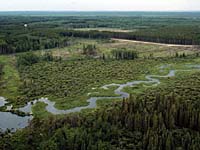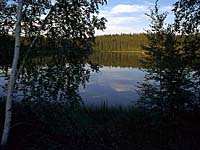
Shoreline vegetation and plants in the water protect fish from sunlight and predators. Clearing of shorelines and inshore vegetation increases water temperature and removes protective feeding, spawning, and nursery habitat.

Trees and shrubs overhanging a stream or lakeshore help moderate water temperature. Because fish are cold-blooded, water temperature controls their body temperature. If the water gets too warm, fish start to die from heat stress. Trout rarely tolerate water warmer then 22oC. |
Warm water holds less oxygen than cold -- which is especially significant in waters already depleted of oxygen from pollution. The combined effect of heat stress and decreasing oxygen levels can rapidly kill fish.
Overhanging vegetation is home to many insects that fall into the water and become food for fish. Leaf litter, twigs, and other organic matter act as a source of nutrients in the food chain.

Cover provided by vegetation also includes partially and fully submerged plants. Aquatic insects grow and reproduce in the vegetation, providing fish with an excellent source of food. Fish can escape predators, or have a rest, by taking refuge among aquatic plants, boulders and undercut stream banks. Many species require rest areas near their spawning grounds. |
Overhanging vegetation and boulders provide instream cover and habitat diversity. Vegetated shorelines are teeming with life and near-shore areas are dynamic food webs, the richest form of habitat.